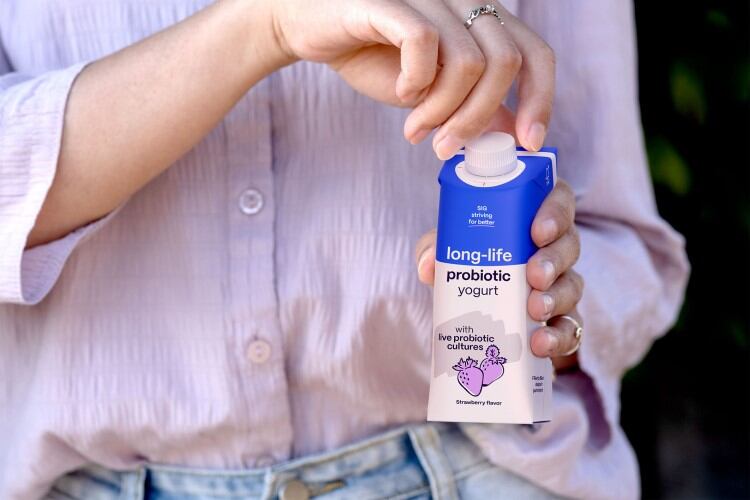A new category of shelf-stable probiotics-fortified dairy products are now possible thanks to a breakthrough accomplished by microencapsulation specialist AnaBio Technologies and packaging giant SIG.
Ireland-based AnaBio told us in March that it was on a brink of developing a disruptive new product – a probiotic beverage that would not require refrigeration. The category would particularly appeal to dairy producers, who would be able to offer long-life drinking yogurts fortified with probiotics, for example.
Company CEO Dr. Aidan Fitzsimons told us: “If we could release the probiotic beverages from the fridge, the untapped market potential is huge. By taking away refrigeration, you are reducing cost, making distribution much easier, and making the delivery of probiotic beverages much more sustainable.” The company estimates that probiotic-enriched drinks made up just 1.5% to 2% of the whole beverage market today, but that could significantly increase if these beverages can be kept outside the fridge.
Producing this novel RTD would spell any new health risks during processing either, according to Fitzsimons: “The only difference [to traditional RTD manufacturing procedure] is that because you’re adding the probiotic in relatively small quantities, it would be ideal if you could create some sort of pre-mix…and then pop that into the larger flow of raw material.”
The microencapsulated probiotics can survive at 140°C/284°F, we were told, making the solution ideal for UHT milks.
Earlier this month, AnaBio and packaging manufacturer SIG jointly announced the industry’s first shelf-stable probiotic-fortified drinking yogurt.
We caught up with the company’s category & consumer insight manager Julia Trebels to find out how SIG approached the R&D process.
DR: You talk about having to apply specific filling and processing parameters to ensure 'a homogenous suspension' of the probiotics in the liquid. Please explain what this entailed and why this 'homogenous suspension' is important to be achieved?
JT: One of the challenges in developing products with encapsulated probiotics is to ensure that the products in the filled packs are homogenous, reproducible, and have equivalent amounts of probiotics per pack – this is also legally required considering on-pack claims. SIG’s filling technology allows to gently process and fill the product with evenly distributed probiotics due to the agitation system before filling. The agitator exerts only a minimal mechanical stress on the product – this prevents cells from being destroyed. They can be evenly distributed in the product.
DR: How does this new type of aseptic packaging - with the new filling and processing parameters that you've applied - compare to your more traditional offerings in terms of recyclability, shelf-life, ability to protect from odours etc?
JT: The beauty of this concept is that it can be run with existing SIG packaging material, and it can be filled with SIG’s standard filling technology. This concept helps to elevate ambient, long-life products to a healthier level and thus fits perfectly into SIG’s vision of providing more healthy food in aseptic packaging to our consumers.
DR: Talking about distribution costs, could you offer an example of the savings that can be made by beverage makers for this type of products when no refrigeration is involved?
JT: The distribution costs of such products vary depending on several individual factors, such as how far it needs to travel, what kind of vehicle is used, and how well the country is equipped with infrastructure. Therefore, the costs have to be calculated case by case. However, one major advantage of our concept is that it does not require any cooling at any stage of the supply chain: it can be stored, transported and displayed without refrigeration. This can significantly reduce the cost of distribution.
DR: How long did it take you to fine-tune this packaging offering and make it right for this type of product? What were some of the challenges on the way and how did you overcome these?
JT: The key challenge of this concept was that it involves not just a packaging solution, but a holistic end-to-end development from product conception to aseptic packaging to processing and filling. In view of this intricacy, we had to devote around 12 months in finding the appropriate partner and technical method to overcome the difficulty of filling probiotic yogurt into aseptic packaging.
DR: Is what you've come with essentially a prototype? Have you been approached by any manufacturers who have an idea to launch their own probiotic-enriched ambient yogurt in the same type of packaging?
JT: Yes, we can say that these are kind of prototypes that make a huge number of alternative product concepts conceivable. The interest from manufactures is high, as the solution can solve multiple challenges for our customers; i.e. no cool-chain needed, extended shelf-life while keeping the nutritional value high. And there is a wide range of probiotics and bioactives that can be encapsulated and packed in SIG packaging, such as: Lactobacillus Probiotic Species, Bifidobacterium Probiotic Species, vitamins, minerals, amino acids, creatine, caffeine, hyaluronic acid or melatonin.




